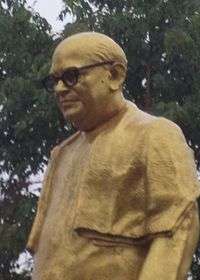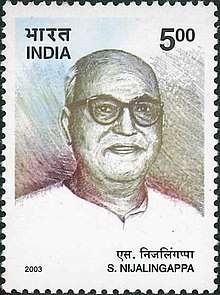S. Nijalingappa
Siddavanahalli Nijalingappa (10 December 1902 – 8 August 2000) was an Indian freedom fighter, Congress Party politician, and lawyer who served two terms as the Chief Minister of Karnataka (then Mysore State) first between 1956 and 1958, and once again from 1962 to 1968.
S. Nijalingappa | |
|---|---|
 Statue of Nijaligappa in Davanagere | |
| 4th Chief Minister of Mysore State | |
| In office 1 November 1956 – 16 May 1958 | |
| Governor | Jayachamarajendra Wadiyar |
| Preceded by | Kadidal Manjappa |
| Succeeded by | B. D. Jatti |
| In office 21 June 1962 – 29 May 1968 | |
| Governor | Jayachamarajendra Wadiyar S. M. Shrinagesh V. V. Giri Gopal Swarup Pathak |
| Preceded by | S. R. Kanthi |
| Succeeded by | Veerendra Patil |
| Personal details | |
| Born | 10 December 1902 Haluvagalu, Bellary, Madras Presidency, British Raj (now in Karnataka, India) |
| Died | 8 August 2000 (aged 97) Chitradurga, Karnataka, India |
| Political party | Indian National Congress |
He played an important role not only in the Indian freedom movement but also the Karnataka Unification movement.
Early life and education
Nijalingappa was born on 10 December 1902 to a middle class family in Haluvagalu, a small village in Bellary, Karnataka[1] (then in the Madras Presidency of British India). His father, a small businessman, died when Nijalingappa was five; his mother was a homemaker. The family were Lingayat Hindus; Nijalingappa's mother was noted as a devout worshipper of Shiva.[1] Nijalingappa later recalled that his "father's ancestors were all rich profligates" and that they "dissipated their wealth on gambling, drinking and womanising." He added that his "mother's father helped [his] parents, but [his family] were still very poor."
He grew up in Davanagere and, as a child, was given a traditional education by Veerappa Master, an elder teacher. He joined a formal, western primary school in Davanagere and then a secondary school in Chitradurga in 1919. He became interested in politics during this time after reading the political writings of Annie Besant.[2] In 1924, he graduated in the Arts from the Central College, Bengaluru, and got his Law degree from the Law College, Pune in 1926.[1]
Thus, like many other leaders of the Indian freedom movement, he received a blend of both traditional Indian-style and Western-style education. He was influenced by the ideologies of Mahatma Gandhi and Rajendra Prasad, and began to take an active part in the freedom movement in his native Karnataka.
Political career
Nijalingappa attended the Congress sessions as a spectator. It was in 1936, when he came into contact with N. S. Hardikar, that he began to take an active interest in the organization. He served it first as a volunteer, rising to be the President of the Pradesh Congress Committee and finally the President of the All India Congress Committee in 1968.
He became president of the Mysore Congress and was also a member of the historic Constituent Assembly from 1946 to 1950. In 1952, he was elected to the First Lok Sabha from the Chitaldrug constituency (now Chitradurga) then in Mysore state.
In recognition of his enormous services towards the unification of Karnataka, he was chosen as the first Chief Minister of the unified state. Then again for the second time, he was elected to the same post and he continued in that post up to April 1968. He may well be called the "Maker of Modern Karnataka". The state owes much to him for development of agricultural, irrigation, industrial and transport projects.[3]
He became the Congress President when people in many parts of the country had expressed their distrust in it in the 1967 elections. He chaired two Congress sessions in 1968 and 1969 held in Hyderabad and Faridabad respectively. Due to his untiring efforts, the Congress Party was re-invigorated. However, the factional feud between various factions of the party increased and finally resulted in the historic split of the party in 1969.[4][5] He was the last president of undivided Indian National Congress and had to see his party being split into Congress (R) that supported Indira Gandhi, and Congress (Organization) or Syndicate Congress that consisted of senior leaders like Nijalingappa himself, Neelam Sanjiva Reddy, Kamaraj and Morarji Desai.[6]
After the Congress split, Nijalingappa gradually retired from politics. After giving up active politics, he served as chairman of Sardar Vallabhbhai Patel Society. He was widely revered even after his retirement and was known for his simplicity and integrity.[7] He died on 9 August 2000 at his residence in Chitradurga at the age of 97.[8]
He is remembered fondly by the Tibetan community of India because as Chief Minister of Karnataka, he gave land to Tibetan refugees for the purpose of resettlement. Karnataka today has the largest Tibetan settlements and the largest population in exile. Bylakuppe, Mundgod, Kollegal and Gurupura (near Bylakuppe) are the four Tibetan settlements in Karnataka.[9]
Post Held
He was an advocate till 1940 when he was debarred on account of political activities. He was a member of the Indian National Congress for thirty years. He became President of Chitaldroog D.C.C. from 1936 to 1940. He was a member of the Mysore Legislative Council, 1937–38 and a member of the Mysore Congress Working Committee, 1938—50 and General Secretary of the Mysore P.C.C., 1942—45; President, Mysore P.C.C., 1945–46; President, Karnataka P.C.C., 1946; Member, Constituent Assembly of India and Provisional Parliament; Member (1948—50) and President, Constituent Assembly of Mysore; Member, Congress Working Committee from 1949; Member, the Gopal Rao Enquiry Committee, Government of Mysore; Advocate of decentralisation of Industry and production and formation of States on linguistic basis.
He is the member of Nijalingappa committee as he is appointed by the planning commission to examine the working of co-operative societies. As result they foundation the co-operative societies were formed by the member of the same family to evade laws.
Clubs: Member, Chitaldroog Club from 1929; its Secretary, 1935—37; Member, Constitution Club, New Delhi.
Special interest: Village and Harijan Uplift, Spinning and Literature.
Permanent address: Chitaldroog (Mysore).
Memorial

The memorial of Nijalingappa built beside NH-4 on the outskirts of Chitradurga near Sibara was inaugurated by the Tibetan spiritual leader, the Dalai Lama on 29 January 2011.[10] Meanwhile, Karnataka chief minister B. S. Yeddyurappa declared that he would name the Sugar research institute at Belgaum after Nijalingappa.[11]
References
- "FACTIONS AND POLITICAL LEADERS" (PDF). p. 193. Retrieved 11 March 2018.
- Riti, M. D. "A politician who rose above politics". Rediff.com. Retrieved 11 March 2018.
- "NIJALINGAPPA – ARCHITECT OF KARNATAKA" (PDF). presidentvenkatraman.in.
- Split in a Predominant Party: The Indian National Congress in 1969. Google book results.
- "From the Archives (November 13, 1969): Prime Minister expelled from Congress". The Hindu. 13 November 2019. ISSN 0971-751X. Retrieved 4 July 2020.
- "Split in the Congress". Indiansaga.
- "Wearing simplicity on the sleeve". Deccan Herald. 6 November 2012.
- "Nijalingappa dead". The Hindu. 9 August 2000.
- "His Holiness the Dalai Lama Remembers Former Chief Minister Nijalingappa". Central Tibetan Administration. 31 January 2011. Archived from the original on 21 March 2013.
- "S. Nijalingappa memorial to be dedicated to the nation today". The Hindu. 29 January 2011.
- "Sugar institute named after Nijalingappa". The Hindu. 28 August 2010.
Further reading
- Nijalingappa, S. (2000). My Life and Politics: An Autobiography. Vision Books. ISBN 9788170944232.
External links
| Wikimedia Commons has media related to Siddavanahalli Nijalingappa. |
- Biography at Indian National Congress website
| Political offices | ||
|---|---|---|
| Preceded by Kadidal Manjappa |
Chief Minister of Karnataka 1 November 1956 to 16 May 1958 |
Succeeded by B. D. Jatti |
| Preceded by S. R. Kanthi |
Chief Minister of Karnataka 21 June 1962 to 29 May 1968 |
Succeeded by Veerendra Patil |